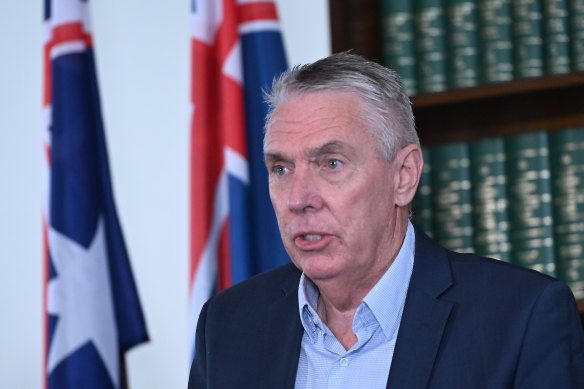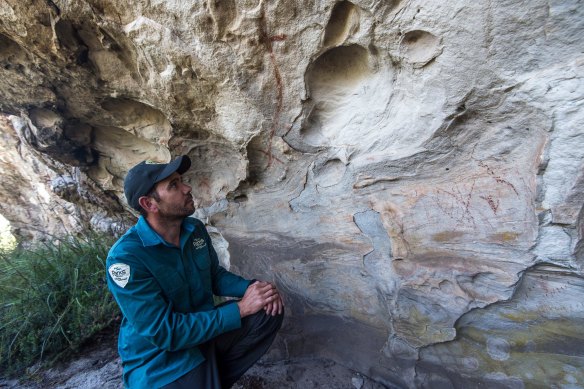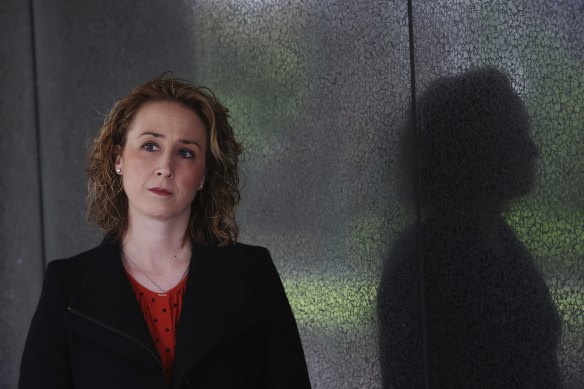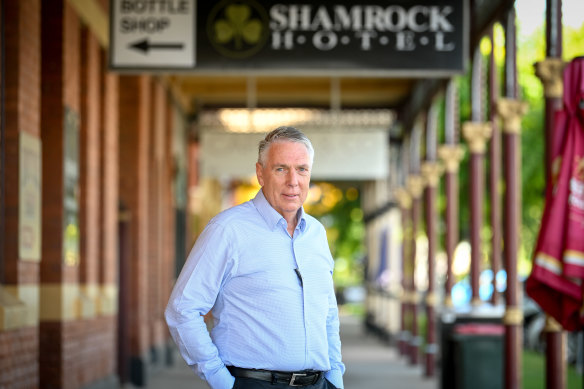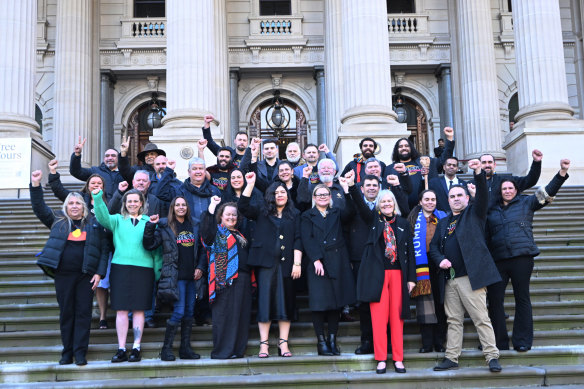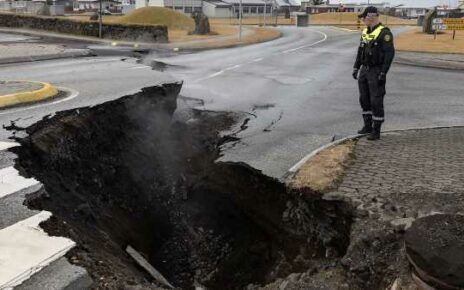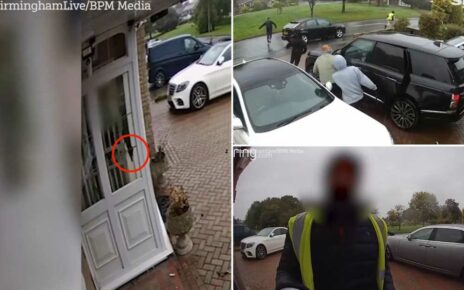Save articles for later
Add articles to your saved list and come back to them any time.
Victorian Nationals Leader Peter Walsh has been accused of spreading misinformation after labelling the state’s decade-old traditional owner agreements an “attack on the rights of all Victorians”.
Walsh used an opinion piece syndicated across several rural and regional newspapers to criticise a recent agreement between the Barengi Gadjin Land Council and the state under the Traditional Owner Settlement Act.
Victorian Nationals leader Peter Walsh has been accused of spreading misinformation.Credit: Justin McManus
The legislation passed through parliament during the Brumby Labor government and has operated since 2011.
Walsh, who is also the opposition spokesman on Aboriginal affairs, said the latest agreement was a “stealth attack” and an “attack on the rights of all Victorians”.
In the Australian Community Media column, Walsh called for Victoria to reassess its cultural heritage protections and “pull back from the brink” of giving Aboriginal groups “sweeping powers to totally rewrite and run everything”.
Walsh wrote in the piece that the Barengi Gadjin agreement, which relates to 10,540 square kilometres (or 1,054,000 hectares) of public land in the Wimmera, Mallee and Gariwerd regions of western Victoria, lacked transparency.
The Gariwerd region includes the Grampians in Victoria’s west.Credit: Justin McManus
“The premier has done his deal in secret and then dumped a fait accompli on the unsuspecting region,” he said.
“You can look around regional Victoria today and see just how far this had got beyond a joke. Look at our cultural heritage overlays, where Indigenous corporations, elders or just about anyone whose heritage identifies with a certain area, have been given enormous, intangible powers over who can and cannot do everything or nothing.”
The comments prompted a sharp rebuke, with experts claiming they were wrong and Labor accusing Walsh of confusing the issue to weaken the case for the federal Voice to parliament.
Native title legal expert and former director of the Victorian Aboriginal Heritage Council Matthew Storey said the Coalition deputy leader’s statement was simply wrong.
“There are no ‘cultural heritage overlays’. Heritage overlays in planning law relate to built (non-Aboriginal) heritage,” Storey said.
“Walsh’s article, either through ignorance or mischievousness, confuses matters dealt with in agreements under the Traditional Owner Settlement Act and cultural heritage management [under the] Aboriginal Heritage Act .
“Either way, it is fairly damning for a shadow Aboriginal affairs minister to get this wrong. Not only does he confuse these two important pieces of legislation, it appears he simply doesn’t understand them.”
Treaty and First Peoples Minister Gabrielle Williams said Walsh’s statements were “dangerous” and part of a campaign of misinformation linked to the looming federal referendum on an Indigenous Voice to parliament.
Minister for Treaty and First Peoples Gabrielle Williams.Credit: Paul Jeffers
“This misinformation has far more to do with an unrelated national discussion (the Indigenous Voice referendum) currently taking place,” Williams said in a statement.
Walsh has backed the federal Nationals party position to oppose the Voice. Last week, state Opposition Leader John Pesutto announced that he did not personally support the Indigenous Voice, but would not be campaigning on either a Yes or a No vote.
Walsh, in his piece, likened the agreement to the Indigenous Voice and the recently scrapped Western Australia cultural heritage protection laws, collectively labelling them as “overreactions” that “exacerbate the sense of division” in community.
The WA Indigenous cultural heritage laws were withdrawn by Premier Roger Cook early last month after months of intense pressure from the state’s mining, farming and pastoralist interests.
The overhauled protections were prompted by the destruction of Juukan Gorge in 2020, where rock shelters blasted by mining giant Rio Tinto contained artefacts and sacred objects that proved 46,000 years of continuous Aboriginal occupation.
The legislation is considered by some groups as a practical alternative to the more lengthy native title recognition process. It allows the Victorian state government and traditional owner groups to make formal agreements that recognise traditional owners’ relationship to land and provides them with limited rights on Crown land.
Williams noted the Barengi Gadjin agreement was the fourth signed by the state government and traditional owners.
“The agreement does not place any legal obligations on local government. It does not impact current council laws and regulations. Local governments are independent of the Victorian government and will determine their own commitments under the agreement,” she said.
Victorian Nationals leader Peter Walsh criticised a recent agreement between the Barengi Gadjin Land Council and the state under the Traditional Owner Settlement Act.Credit: Eddie Jim
The Napthine Coalition government, in which Walsh sat as minister for water, agriculture and food security, signed the state’s second agreement in 2013.
Barengi Gadjin Land Council chairperson Dylan Clarke said Walsh’s comments “feel like a bunch of random complaints being lumped together” and then blamed on First Peoples and traditional owners.
Clarke, who also sits in the First People’s Assembly of Victoria, urged Walsh and other politicians to engage with the council in a “proper conversation”.
“If the politicians have questions, we’re always up for a yarn. It’s in everyone’s interests to get this right, so our door is always open,” he said.
The First People’s Assembly of Victoria at Parliament House in July.Credit: Justin McManus
Storey said that under the Traditional Owner Settlement Act agreements, a group like the Barengi Gadjin Land Council can only refuse a cultural heritage management plan to undertake activities if the plan does not effectively “avoid or minimise” harm to Aboriginal cultural heritage.
Cultural heritage management plans were required only where an activity would have a significant impact upon an area of high cultural sensitivity, and where that area has not already been the subject of significant ground disturbance.
“If the Recognised Aboriginal Party doesn’t approve the plan, the proponent can seek review at VCAT. If there is no RAP, the (department) secretary approves the plan. The department may insist that a developer consults with identified traditional owners, but it is only a requirement to consult. There are no ‘enormous intangible powers’,” Storey said.
Asked to respond to the criticism, Walsh said he had met with a co-chair and the chief executive of the First People’s Assembly after the publication of the piece. “I raised issues of cultural heritage that need to be addressed, and it was a productive and respectful discussion,” he said.
“What’s in place now has gone further than what was originally signed off on by the Baillieu government.”
First Peoples’ Assembly co-chair Ngarra Murray said conversations about giving Aboriginal people more authority in decisions about cultural heritage protection and caring for Country were not easy, but “very worthwhile” and “long overdue”.
“Whether it’s the Voice to parliament at a national level or the journey to Treaty here in Victoria, the conversations are about finding better ways of doing things.”
Get the day’s breaking news, entertainment ideas and a long read to enjoy. Sign up to receive our Evening Edition newsletter here.
Most Viewed in National
From our partners
Source: Read Full Article
